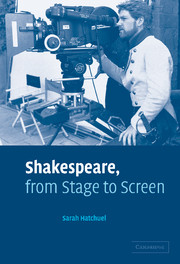Book contents
- Frontmatter
- Contents
- Acknowledgments
- 1 Shakespeare, from stage to screen: a historical and aesthetic approach
- 2 From theatre showing to cinema telling
- 3 Masking film construction: towards a ‘real’ world
- 4 Reflexive constructions: from meta-theatre to meta-cinema?
- 5 Screenplay, narration and subtext: the example of Hamlet
- 6 Case studies
- Bibliography
- Index
4 - Reflexive constructions: from meta-theatre to meta-cinema?
Published online by Cambridge University Press: 22 September 2009
- Frontmatter
- Contents
- Acknowledgments
- 1 Shakespeare, from stage to screen: a historical and aesthetic approach
- 2 From theatre showing to cinema telling
- 3 Masking film construction: towards a ‘real’ world
- 4 Reflexive constructions: from meta-theatre to meta-cinema?
- 5 Screenplay, narration and subtext: the example of Hamlet
- 6 Case studies
- Bibliography
- Index
Summary
In the theatre, there is a broad spectrum of ways to present Shakespeare's plays, from the illusions of the realistic pictorial stage to Bertolt Brecht's epic theatre, depleted of realistic effects and calling attention to the medium. This chapter will attempt to answer the following questions: is it possible for screen adaptations to adopt the devices of Brechtian presentation? Can the cinema reflect the mises-en-abyme (i.e. embedded structures and mirror constructions) that can be found in Shakespeare's plays? Can films defamiliarize the spectators with a play so that they can reach an alienated state of critical distance?
Brecht wished for plays to move away from conducted plots in favour of an anti-illusionist succession of independent events. In this view, the relationships linking the scenes with one another should be more important than the relationships between them and the ending. Epic theatre is structured episodically with highly contrasted scenes and without finality, giving rise to alienation and implying variability. Alienation is also created through dramaturgical devices such as asides, choruses, commenting figures, prologues and epilogues, and the exposure of theatrical machinery to the spectators. The aim is to avoid the audience's identification with the characters on stage, and to encourage distance and criticism. The actors are revealed as actors, the props as props, the sets as sets. According to Manfred Pfister in his 1991 book The Theory and Analysis of Drama, ‘This emphasises the difference between the reality of the objects and the objects they represent, and imbues them with epic mediating qualities.
Information
- Type
- Chapter
- Information
- Shakespeare, from Stage to Screen , pp. 94 - 126Publisher: Cambridge University PressPrint publication year: 2004
